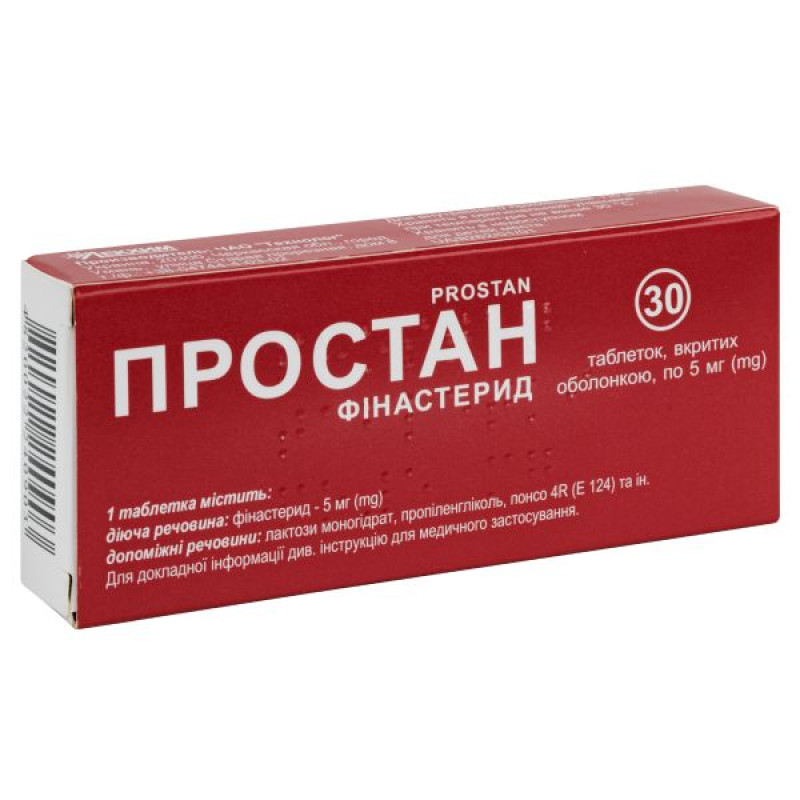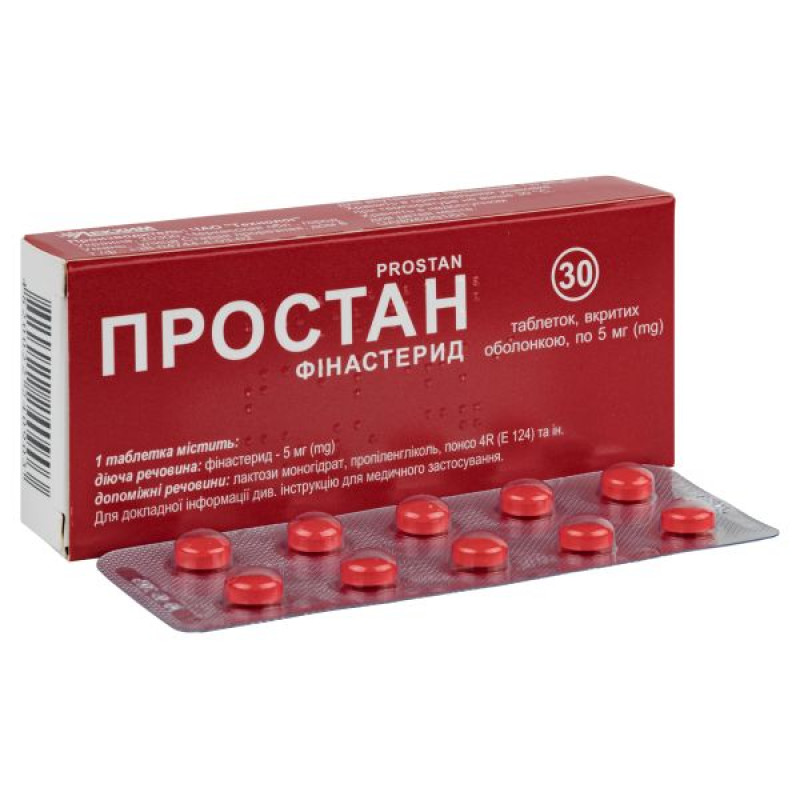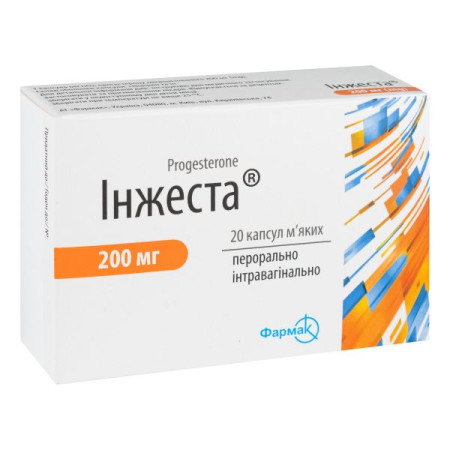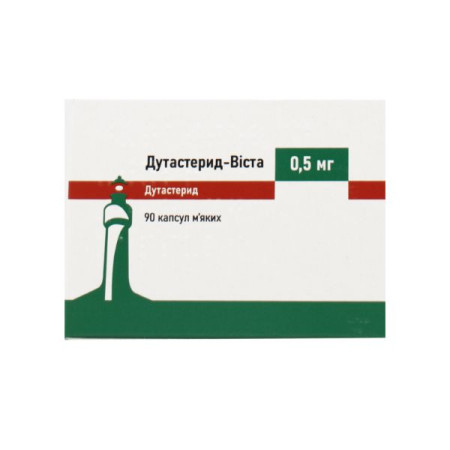Prostan film-coated tablets 5 mg blister No. 30

Instructions Prostan film-coated tablets 5 mg blister No. 30
Composition
active ingredient: finasteride;
1 tablet contains finasteride 5 mg;
excipients: lactose monohydrate, potato starch, povidone 25, croscarmellose sodium, magnesium stearate, microcrystalline cellulose, hypromellose (hydroxypropylmethylcellulose), propylene glycol, titanium dioxide (E 171), polysorbate 80, talc, polyethylene glycol 6000 (macrogol 6000), Ponceau 4R dye (E 124).
Dosage form
Film-coated tablets.
Main physicochemical properties: round, coated tablets of reddish-pink color, convex on the upper and lower surfaces; when broken, when viewed under a magnifying glass, a core surrounded by one continuous layer is visible.
Pharmacotherapeutic group
Drugs used for benign prostatic hypertrophy.
ATX code G04C B01.
Pharmacological properties
Pharmacodynamics.
Finasteride is a specific inhibitor of 5-alpha-reductase type II, an intracellular enzyme that converts testosterone to the more active androgen dihydrotestosterone (DHT). Prostate enlargement in benign prostatic hyperplasia (BPH) is dependent on the conversion of testosterone to DHT in prostate tissue. Finasteride is highly effective in reducing both circulating and intraprostatic DHT. Finasteride has no affinity for androgen receptors.
In patients with moderate to severe BPH, an enlarged prostate gland, and low residual urine volume, the drug reduced the frequency of acute urinary retention and the need for surgical intervention (transurethral resection of the prostate and prostatectomy). This was accompanied by a 2-point improvement in the QUASI-AUA symptom assessment scale (range 0-34), a significant regression of prostate volume, and an increase in urinary flow rate.
Studies have shown that treatment with finasteride, doxazosin, or their combination significantly reduces the risk of clinical progression of BPH compared to placebo. The risk of acute urinary retention is lower in the finasteride, doxazosin, or their combination groups compared to placebo.
Pharmacokinetics.
In men, after a single oral dose of 14C-labeled finasteride, 39% of the dose was excreted in the urine as metabolites (presumably, a small amount of unchanged finasteride was also excreted in the urine), 57% of the dose was excreted in the feces. Studies have also shown that two metabolites of finasteride have a less pronounced inhibitory effect on 5-alpha-reductase. The bioavailability of finasteride when taken orally is approximately 80%. Food intake does not affect the bioavailability of the drug. The maximum concentration of finasteride in the blood plasma is achieved approximately 2 hours after oral administration. Absorption of the drug from the gastrointestinal tract ends 6-8 hours after its intake. The half-life of finasteride from blood plasma is on average 6 hours. Binding to plasma proteins is 93%. Systemic clearance is approximately 165 ml/min, volume of distribution is 76.1 liters.
In elderly patients, the rate of finasteride elimination is somewhat reduced. In men over 70 years of age, the half-life of finasteride is approximately 8 hours, while in men aged 18 to 60 years, it is 6 hours. However, this is not an indication for reducing the dose of the drug in elderly patients.
In patients with chronic renal failure (creatinine clearance from 9 to 55 ml/min), no difference in the rate of elimination of a single dose of finasteride labeled with carbon isotopes 14C was found compared to healthy volunteers. Binding to plasma proteins in these groups of patients was also not different. This is explained by the fact that in patients with renal failure, the proportion of finasteride metabolites that is normally excreted in the urine is excreted in the feces. This is confirmed by an increase in the amount of finasteride metabolites in the feces in these patients with a simultaneous decrease in their concentration in the urine. Therefore, for patients with renal failure for whom hemodialysis is not indicated, dose adjustment of the drug is not required.
There are no data on the pharmacokinetics of the drug in patients with hepatic insufficiency.
Finasteride crosses the blood-brain barrier. Small amounts of finasteride have been detected in seminal fluid.
Indication
Treatment and control of BPH in patients with enlarged prostate gland to:
reduction in size (regression) of the enlarged gland, improvement in urine flow, and reduction of symptoms associated with BPH;
reducing the risk of acute urinary retention and the need for surgical intervention, including transurethral resection of the prostate and prostatectomy.
Contraindication
Hypersensitivity to finasteride or to any component of this drug.
Prostan is not indicated for use in women and children.
Pregnancy: use in pregnant women or women who may potentially be pregnant (see section “Use during pregnancy or breastfeeding”).
Interaction with other medicinal products and other types of interactions
No clinically significant drug interactions have been identified. Finasteride does not appear to have a significant effect on the enzyme system that metabolizes drugs that are involved in cytochrome P450 metabolism. Although the risk of finasteride affecting the pharmacokinetics of other drugs is considered low, it is likely that inhibitors and inducers of cytochrome P450 3A4 will affect the plasma concentrations of finasteride. However, given the established safety profile, any increase in finasteride concentrations associated with concomitant use of cytochrome P450 3A4 inhibitors is unlikely to be clinically significant. Compounds tested in humans include propranolol, digoxin, glyburide, warfarin, theophylline, and antipyrine; no clinically significant interactions were found.
Application features
General measures
Patients with large residual urine volume and/or severely reduced urine output should be closely monitored for the possible development of obstructive uropathy.
Effect of the drug on prostate-specific antigen (PSA) and prostate cancer diagnosis
To date, there is no evidence of a beneficial clinical effect of finasteride treatment in patients with prostate cancer. Patients with benign prostatic hyperplasia and elevated PSA levels have been followed in controlled clinical trials with multiple PSA measurements and prostate biopsy. In these trials, finasteride treatment did not affect the incidence of prostate cancer. The overall incidence of prostate cancer was not significantly different between the finasteride and placebo groups.
It is recommended that patients be screened for prostate cancer by digital rectal examination and other methods before and during treatment. Serum PSA is also used to detect prostate cancer. In general, a baseline PSA level of more than 10 ng/mL (Hybritech) should prompt careful evaluation, including biopsy if necessary. Further evaluation is recommended for PSA levels between 4 and 10 ng/mL. There is considerable overlap in PSA levels between men with and without prostate cancer. Therefore, in men with benign prostatic hyperplasia, normal PSA values do not exclude prostate cancer, regardless of treatment. A baseline PSA level of less than 4 ng/mL does not exclude prostate cancer.
Finasteride causes a decrease in serum PSA by approximately 50% in patients with benign prostatic hyperplasia, even in the presence of prostate cancer. This decrease should be taken into account when assessing PSA levels, as it does not exclude concomitant prostate cancer. The decrease is expected across the entire range of PSA values, although it may vary in individual patients. In most patients who use the drug for 6 months or more, PSA values should be doubled compared to normal values in individuals who do not use this drug. This correction allows maintaining the sensitivity and specificity of PSA determination and detecting prostate cancer.
Any prolonged increase in PSA levels in patients taking finasteride, 5 mg, requires careful evaluation to determine the cause, including non-adherence to the drug regimen.
Effect of the drug on laboratory data
Impact on PSA levels
Serum PSA levels correlate with patient age and prostate volume, with prostate volume correlating with patient age. When evaluating laboratory PSA values, it is important to consider the fact that PSA levels decline during treatment with the drug. Most patients experience a rapid decline in PSA during the first few months of treatment, after which PSA levels stabilize at a new level that is approximately half of baseline. Therefore, in patients taking the drug for 6 months or more, PSA values should be doubled compared to normal values in individuals not taking the drug.
Finasteride does not significantly reduce the percentage of free PSA (the ratio of free PSA to total). The ratio of free to total PSA remains constant even under the influence of the drug. When determining the percentage of free PSA, which is used to diagnose prostate cancer, correction of its values is not required.
Breast cancer in men
During clinical trials and in the post-marketing period, breast cancer has been reported in men taking finasteride, 5 mg. Physicians should instruct their patients to immediately report any changes in breast tissue, such as swelling, pain, gynecomastia, or nipple discharge.
Lactose
The drug contains lactose, therefore patients with rare hereditary forms of galactose intolerance, lactase deficiency or glucose-galactose malabsorption syndrome should not use it.
Liver failure
The effect of hepatic insufficiency on the pharmacokinetics of finasteride has not been studied.
Use during pregnancy or breastfeeding
Pregnancy.
Women who may become pregnant or are pregnant should avoid contact with crushed or damaged Prostan tablets.
There is evidence of small amounts of finasteride being excreted in the semen of a patient taking finasteride at a dose of 5 mg/day. It is not known whether a male fetus may be adversely affected if its mother has been exposed to the semen of a patient treated with finasteride. If the patient's sexual partner is pregnant or potentially pregnant, the patient should be advised to prevent exposure of the partner to semen.
Due to the ability of 5-alpha-reductase type II inhibitors to inhibit the conversion of testosterone to DHT, these drugs, including finasteride, may cause abnormalities in the development of the external genitalia in a male fetus.
Prostan tablets are coated, so this prevents contact with the active ingredient, provided that the tablets are not crushed or have lost their integrity.
Breastfeeding period.
Prostan is not indicated for women. It is not known whether finasteride passes into breast milk.
Ability to influence reaction speed when driving vehicles or other mechanisms
Does not affect the ability to drive a car or operate machinery.
Method of administration and doses
The recommended dose is 1 tablet of 5 mg once a day. Take regardless of meals.
Prostan can be used as monotherapy, as well as in combination with the alpha-blocker doxazosin (see section "Pharmacological properties").
The duration of treatment is determined by the doctor individually. Although the patient's condition may improve earlier, to assess the effectiveness of the drug, it is necessary to take the drug for at least 6 months, after which treatment should be continued.
For elderly patients and for patients with renal insufficiency of varying severity (decrease in creatinine clearance to 9 ml/min), dose adjustment is not required.
There are no data on the use of the drug in patients with impaired liver function.
Do not use on children.
Children
Prostan is contraindicated in children.
The safety and effectiveness of the drug in children have not been established.
Overdose
In patients who used finasteride at a dose of up to 400 mg once and finasteride at a dose of up to 80 mg/day for 3 months, there were no undesirable effects.
There are no specific recommendations for the treatment of finasteride overdose.
Side effects
The most common adverse reactions are impotence and decreased libido. These adverse reactions occur early in the course of therapy and resolve with continued treatment in most patients.
From the immune system.
Hypersensitivity reactions including itching, urticaria and angioedema (including swelling of the lips, tongue, throat and face).
From the psychological side.
Decreased libido, which may persist after discontinuation of therapy, depression.
From the side of the cardiac system.
Rapid heartbeat.
From the liver and biliary tract.
Elevated liver enzymes.
On the part of the skin and subcutaneous tissues.
Rash, itching, hives.
From the reproductive system and mammary glands.
Impotence, ejaculation disorder, breast tenderness and enlargement, testicular pain, erectile dysfunction, which may persist after discontinuation of treatment; male infertility and/or reversible sperm quality disorders (normalization or improvement of sperm quality has been reported after discontinuation of finasteride).
According to research.
Decreased ejaculate.
Additionally, breast cancer has been reported in clinical trials and postmarketing experience in men taking finasteride. You should immediately report any changes in your breast tissue, such as swelling, pain, gynecomastia, or nipple discharge, to your doctor.
When comparing the safety profiles of finasteride (5 mg/day) and doxazosin (4 or 8 mg/day) monotherapy with the combination therapy of finasteride (5 mg/day) and doxazosin (4 or 8 mg/day) and placebo, the safety and tolerability profile of the combination therapy was consistent with the safety profile of the individual components. The incidence of ejaculation disorders in patients receiving combination therapy was comparable to the sum of the adverse reactions of the two monotherapies.
There is no information on the association between long-term use of finasteride and tumors (with Gleason scores 7-10).
Laboratory research data.
When evaluating PSA laboratory data, it should be noted that PSA levels decrease in patients taking finasteride. In most patients, a rapid decrease in PSA occurs during the first few months of therapy, after which the PSA level stabilizes to a new baseline. The baseline level after treatment is approximately half the pretreatment value. Therefore, in most patients taking finasteride for 6 months or more, PSA values should be doubled to compare with the normal ranges in untreated men.
There were no other differences between patients taking finasteride and patients taking placebo in standard laboratory tests.
Expiration date
2 years.
Storage conditions
Store in the original packaging at a temperature not exceeding 30 °C.
Keep out of reach of children.
Packaging
10 tablets in a blister; 1 or 3 blisters in a cardboard pack.
Leave category.
According to the recipe.
Vacation category
According to the recipe.
Producer
Technolog PJSC.
Address
Ukraine, 20300, Cherkasy region, Uman city, Stara Prorizna Street, building 8.
There are no reviews for this product.
There are no reviews for this product, be the first to leave your review.
No questions about this product, be the first and ask your question.















